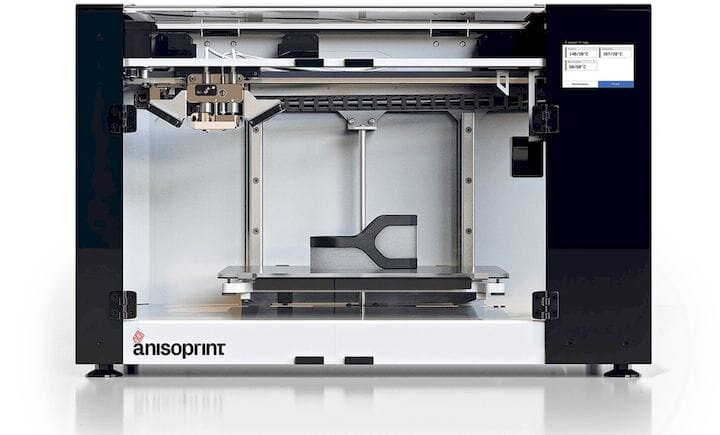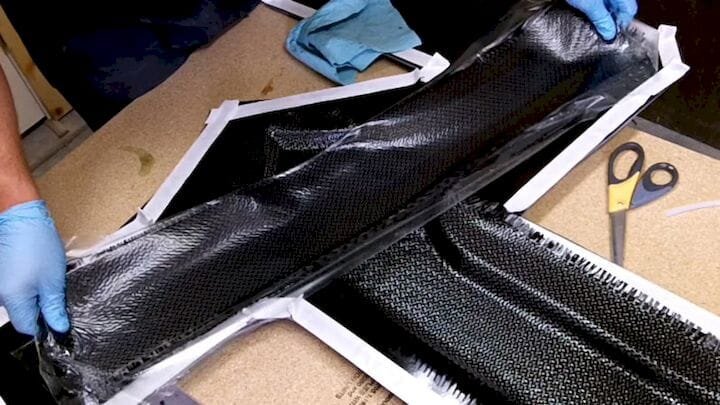 The Composer 3D printer from Anisoprint. (Image courtesy of Anisoprint.)
The Composer 3D printer from Anisoprint. (Image courtesy of Anisoprint.)
In the field of composite 3D printing, Markforged is highlighted as a pioneer, given the 2014 release of its continuous carbon fiber printing system. And while many other firms are slowly filling the space with their own unique processes for 3D printing with composites, there may be no other more direct competitor than Anisoprint.
The Russia- and Luxembourg-based startup first introduced a similar, yet quite different method for 3D printing carbon fiber in 2014. In the past year in particular, Anisoprint has made a series of announcements demonstrating that it may be ready to take on the competition. To learn more, we spoke to its CEO, Fedor Antonov.
How Composites Are Made
To understand Anisoprint’s composite 3D printing process, it’s useful to differentiate the three varieties of composite manufacturing techniques that are currently used. Composites are made up of a reinforcement fiber, such as carbon or glass fiber, and a matrix material, such as a polymer.
One approach to making parts that are reinforced with a fiber material involves using a reinforcement fiber pre-impregnated with a polymer matrix, resulting in what the industry calls a “prepreg.” This stock, preformed material—usually a weaved fabric—can then be used for a variety of applications, such as forming an autobody part for a racecar.
 Pieces of carbon fiber being laid into a mold that will be filled with epoxy resin and vacuum sealed. (Image courtesy of The Project Junkie.)
Pieces of carbon fiber being laid into a mold that will be filled with epoxy resin and vacuum sealed. (Image courtesy of The Project Junkie.)
If a part is not made with a prepreg, the reinforcement fiber can be impregnated as an element of the part itself. For instance, a carbon fiber cloth might be placed into a mold in the shape of the final component, before the mold is filled with an epoxy and cured.
Finally, the third option, is that the fiber is simultaneously impregnated with the matrix material at the same time that the form of the part is being made.
Whereas the prepreg approach results in a great deal of control over the quality of the material, it is limited in terms of the final form that the part can be made from, as the prepreg must fit into or be modified to fit into the desired shape. The second approach allows for greater flexibility of the final form, but the material quality is usually lower than what is found in prepregs.
Here it’s worth noting that in pretty much all fiber composite manufacturing, individual fibers are laid out in one direction before a second layer of fibers is laid out in the opposite direction. This is because the fibers only exhibit their desired physical characteristics along the grain. If a part is to exhibit those properties in all directions (a feature known as “isotropy”), additional layers with different fiber orientations must be used to compensate. The concept of isotropy is crucial to the advantages of Anisoprint’s technology and will be discussed in greater detail further down.
What Is Composite Fiber Co-Extrusion?
Markforged’s continuous filament fabrication process actually relies on the prepreg approach. Carbon fiber is pre-impregnated with the thermoplastic nylon. With only one input and one output, the printer itself has a single channel from which the fiber is extruded.
 A diagram of how CFC works. (Image courtesy of Anisoprint.)
A diagram of how CFC works. (Image courtesy of Anisoprint.)
In the case of Anisoprint’s composite fiber coextrusion (CFC) technique, there are two inputs and one output; one input is dedicated to the reinforcement fiber and the other is dedicated to extruding thermoplastic. How this works is that, rather than using a reinforcement material pre-impregnated with thermoplastic, which is very viscous in its liquid state, Anisoprint pre-impregnates the dry fiber with extremely liquid thermoset resin that is then cured into a solid state. This virtually eliminates the odds of introducing air bubbles and voids into the material.
The thermoset prepreg fiber is then extruded together with a traditional desktop 3D printing filament made from thermoplastic. The thermoset matrix within the reinforcement material can then bond well with the thermoplastic filament.
The Benefits of CFC
What this means is that CFC is not necessarily limited in terms of the plastics that can be extruded and merged with the reinforcement fibers. Recently, Anisoprint partnered with Chinese filament manufacturer Polymaker to create profiles of 3D printing filaments that can be used in conjunction with Anisoprint’s reinforcement materials. This includes PETG, ABS, PC, PLA and PA.
 Different types of reinforcement with CFC. (Image courtesy of Anisoprint.)
Different types of reinforcement with CFC. (Image courtesy of Anisoprint.)
As for reinforcement materials, Anisoprint currently offers a carbon fiber and basalt. The firm’s carbon fiber composite is 20 times stiffer and stronger than traditional plastic with strength and stiffness-to-weight ratios that are five times greater than 2024-T351 aluminum, while remaining seven times lighter and stronger than steel.
Basalt offers similar properties to fiberglass and is a cheaper alternative to carbon fiber, in that it is 15 times stiffer and stronger than traditional plastic, five times lighter than steel, and features a strength-to-weight ratio twice that of 2024-T351 aluminum. It is also nonconductive.
In addition to using a wider material set, CFC can actually control the rate of deposition of said plastic. As a result, some very unique structures and properties can be achieved. In particular, CFC is capable of printing lattice structures, something otherwise impossible in traditional composite manufacturing.
This is in part due to the fact that when fiber-reinforced elements cross over one another in a component, that area doubles in thickness. However, because CFC can control the flow of the thermoplastic as it is printing, it can reduce plastic deposition substantially as elements overlap.
Read more at ENGINEERING.com

